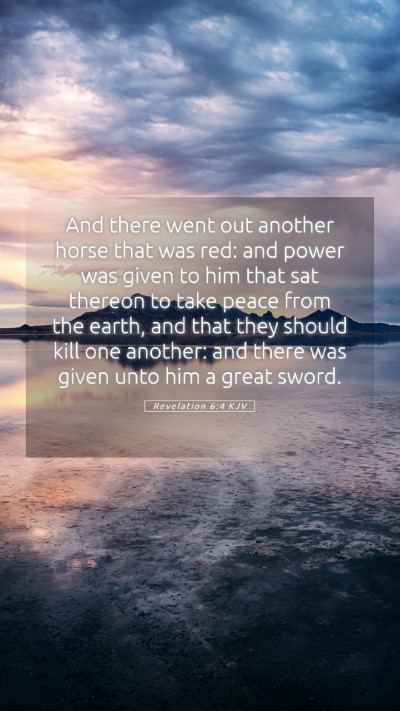Understanding Revelation 6:4
Revelation 6:4 states: "And another horse, fiery red, went out. It was granted to the one who sat on it to take peace from the earth, and that people should kill one another; and there was given to him a great sword." This verse is rich in symbolism and carries significant meaning within the broader context of the Book of Revelation and biblical prophecy.
This passage describes the second of four horses, often referred to as the "Four Horsemen of the Apocalypse". The implications of the color red, the sword, and the concept of peace being taken from the earth are deeply poignant and reflect themes of conflict and turmoil in the last days.
Bible Verse Meanings and Interpretations
- Symbolism of the Red Horse:
The red horse represents warfare and bloodshed. The color red is traditionally associated with violence, and this imagery highlights the catastrophic implications of conflict among nations and individuals.
- Taking Peace from the Earth:
The removal of peace signifies a period of strife and chaos. The verse reflects a time foretold in the biblical narrative where societal harmony is disrupted, leading to hostility between people.
- The Great Sword:
The sword often symbolizes authority and the power to inflict death. Here, it is indicative of the relentless nature of war and the violent means by which it occurs. This serves as a warning about the dangers of unrestrained aggression.
Scripture Analysis and Commentary
According to Matthew Henry’s Commentary, this passage serves as a dire warning about the inevitability of conflict in the latter days. He highlights God's sovereignty in allowing the unfolding of such events, suggesting that these occurrences serve a divine purpose within the grand narrative of redemption.
Albert Barnes emphasizes that the imagery presents the divine permission granted to bring about turmoil as a precursor to the ultimate fulfillment of God's plans. This reflects a view of history where divine oversight is at play even amid the chaos.
Adam Clarke further elaborates on the nature of conflict, suggesting that this phase represents not just physical violence but also a spiritual battle, where the foundations of human relationships are eroded by strife and division.
Historical Context
Understanding this verse also requires consideration of its historical context. The Book of Revelation was written during a time of great persecution for early Christians. The imagery of war and bloodshed would resonate deeply with those experiencing upheaval and turmoil in their lives.
Applying Bible Verses to Daily Life
For modern readers, Revelation 6:4 serves as both a cautionary tale and an invitation to pursue peace actively. In an era rife with conflict, this verse encourages individuals to seek reconciliation and understanding rather than allow hostility to take root in their hearts and communities.
Additional Bible Cross References
- Matthew 24:6-7 - Prophecies of wars and rumors of wars.
- James 4:1-2 - The source of wars and conflicts among people.
- Revelation 6:8 - The third horseman, further illustrating devastation.
- Luke 21:10-11 - Signs of the end times involving turmoil and betrayal.
Conclusion
Revelation 6:4 encapsulates profound themes surrounding humanity's struggle with conflict and violence. By engaging with this verse through various lenses—literal, historical, and spiritual—readers can gain a richer understanding of its implications for both their daily lives and the broader biblical narrative.


